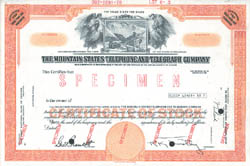Telecommunications History Group Resources
Telephone Company Histories
Mountain States Telephone Company
 Location: Denver, Colorado
Location: Denver, Colorado
Started: 1911
Sold to/Ended: Per federal mandate, divested from AT&T and merged with NWB and Pacific Northwest Bell to form US WEST Co., 1984.
History: Mountain States Telephone & Telegraph Co. came about through a Theodore Vail plan to reorganize and streamline AT&T. Colorado Telephone was considered by Vail and the financial community to be the best managed company of the three companies combined to form Mountain States. Rocky Mountain Bell operated in a financially risky way. The Tri-State company was merely a small, fully- owned subsidiary of the Colorado Company. After the formation of Mountain States, managers of Rocky Mountain Bell were lucky to be demoted rather than fired. Auditors from the former Colorado Company uncovered a striking variety of interesting business practices as they slowly made their way through the former Rocky Mountain Bell Company’s exchanges.
The Billings Plant Department is a prime example. Carl Hill, Jr., a former Mountain Bell assistant vice president, tells this story about his father. The senior Hill joined Rocky Mountain Bell in 1906 as a clerk in the Billings Plant Department. He’d noticed things like reels of new copper wire being chopped up in 3-foot pieces and sold for scrap–the scrap payments going into the foreman’s pocket.
On the day the auditors were to arrive in Billings on the train from Denver, Carl, Sr. arrived at work to find that every plant manager had left town.
The senior Hill was no dummy. He quickly typed a promotion slip naming himself as the new wire chief in Helena and signed it with a signature he was authorized to use. On his way out of town he picked up the Billings’ chief operator who he married after they arrived in Helena. The third generation of the Hill family is now serving with the telephone company.
The detailed history of Mountain States, better known as Mountain Bell, is available in Muttering Machines to Laser Beams, by Herbert Hackenburg
